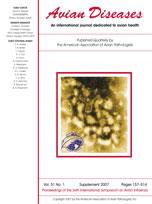Since 2000, hundreds of H9N2 viruses have been isolated from all types of domestic birds. Although H9N2 is a low-pathogenicity virus, disease has been observed in all types of poultry in the field. Clinical signs ranged from very mild disease to high morbidity and mortality when the virus was associated with a secondary pathogen. Because of the wide range of the virus and the great losses it caused, initially a local vaccination program was implemented, but mass vaccination was quickly authorized. A local strain, isolated in 2002 was selected and is currently in use as an inactivated vaccine. An intensive operation is in progress to characterize the isolates.
Several genes (hemagglutinin [HA], neuraminidase, nonstructural protein, nucleoprotein, and matrix) were sequenced, revealing three main groups: the first group included two isolates from 2000, the second group included isolates from 2001 to the beginning of 2003, and the third group included all isolates from 2003 to date. The differences between the second and third groups, in a part of the HA gene, ranged from 3.49% to 6.97% (average 4.57%) of the nucleotides. Similar differences were recorded in the other tested genes. These data could indicate the probable introduction of distinct progenitor viruses into the Israeli poultry population.
Furthermore, sequencing of the HA protein of some Israeli isolates revealed the presence of L216 in the binding site; this finding was typical of the H9N2 viruses isolated from humans, which raises the possibility of an influence on host specificity and virulence.





